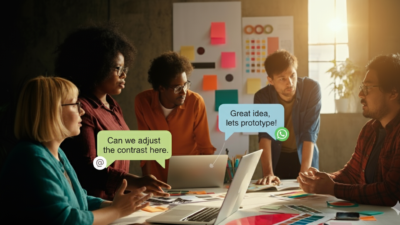Step into any creative meeting and you’ll probably hear the term “vibes” tossed around. The excitement of brainstorming, the spark of an idea, the energy in the room when things are flowing, everything just clicks. That’s the beauty of creative work and a big part of a thriving creative culture : the vibe.
But then, the next day arrives. And the day after that. The “brilliant idea” needs to be turned into a real thing. And suddenly, the “good vibes” aren’t enough. The magic seems to have disappeared. The energy that got you started can’t tell you who is doing what, when it needs to be finished, or how to handle a mistake.
This is a common struggle for creative teams. We love the feeling of just going with the flow, but we also need to get things done on time and do it well, every single time. We want the magic of the “vibe” but we forget the hard work of the “process.” While “vibes” are great for sparking ideas, they’re not enough to build a creative culture that can actually last and grow. For that, you need something more. You need a process.In this blog, we’re going to dig into why processes are crucial for creative teams and why vibes alone won’t cut it when you’re scaling up.
Why We Love the “Vibe”

Truth is – working with good vibes is just plain fun. It’s that feeling when everything just flows, and the team is in sync without even trying. It’s the quick chat that turns into a groundbreaking new project. It’s the late night fueled by coffee and a shared passion for a goal. It’s the kind of work we dream about.
Think about these examples:
The Startup Marketing Team: The office is buzzing. A new product is about to launch, and they’re throwing ideas around. “Let’s do a viral TikTok dance!” or “What if we make a really funny video?” The excitement is contagious, and decisions are made on gut feeling and shared excitement.
The Freelance Designer: A designer is completely focused, headphones on, building an amazing new website. Her way of working is her own personal rhythm, a morning coffee ritual and a certain playlist in the evening. It’s just what feels right to her.
In these moments, the creative energy is real and powerful. The work feels authentic, born from passion. And this is why “vibes” are so important to build that creative culture. They create a safe and fun place to work and give everyone a shared purpose. They are the emotional fuel for creativity.
But that fuel can only get you so far on its own.
The Moment the “Vibe” Fails
The problem with relying only on “vibes” is that they can’t be controlled. They come and go. You can’t schedule a feeling of inspiration. And when you’re trying to build something bigger, when you need to grow your team, deliver great work consistently, and meet business goals – the lack of a process becomes a major problem for your creative culture.
Here’s what happens when it’s all vibes and no process:
1. The Quality Rollercoaster: The first project might be perfect. The next one might feel rushed. The third might look like a mess. Without a clear way to check and improve your work, quality becomes unpredictable. What worked once by luck won’t work every time, right?
2. The Growth Problem: When your small team of five needs to become a team of twenty, the unspoken “vibe” breaks. New people won’t know the inside jokes or the secret handshakes. They need clear instructions, ways to talk to each other, and a clear workflow to be effective. Relying on people to just “pick it up” is a recipe for disaster.
3. The Unpredictable Schedule: When will the project be finished? Saying “I don’t know, when it feels ready” isn’t an answer that a client or your boss will accept. Without a process for planning and tracking progress, deadlines get missed. This leads to stress, missed chances, and a loss of trust.
4. The Communication Mess: When there’s no clear way to share updates or give feedback, people start working on their own, not knowing what others are doing. This leads to doing the same work twice, conflicting ideas, and a general feeling of being disconnected. The team might be “vibing,” but they’re not working together well. This can hurt a thriving creative culture.
The Secret: Building a Process
The solution is not to get rid of the vibes. That would kill creativity. The solution is to create a process that helps the vibe, not hurts it. Think of it not as a bunch of boring rules, but as a simple guide that keeps your creativity on track.
Here are a few simple ways to start building that process:
The Kickoff and Brainstorming Plan
Brainstorms don’t have to be messy free-for-alls; a little structure can actually spark more creativity. Start with a clear problem statement – what are we here to solve? and make sure every voice is heard. Tools like Miro can fuel collaboration and help visualise ideas in real time.
The Simple Project Plan
You don’t need a massive, feature-stuffed project management tool that feels heavier than the project itself. Most creative teams don’t thrive in environments filled with endless dashboards, dependencies, and settings, it’s overwhelming and distracts from the actual work. Start small, but start. Break big projects into smaller, actionable tasks. Assign each to the right person, and add deadlines that feel realistic. Suddenly, what felt overwhelming becomes manageable. ButtonShift’s Worklist is designed exactly for this – simple, visual, and easy to track, making it a perfect fit for creative teams.
The Feedback Loop
Feedback often derails creative culture when it’s scattered or not well articulated, but a simple system keeps it constructive. Decide who gives feedback, when in the process it happens, and what it should focus on – big-picture or small tweaks? ButtonShift’s Feedback feature allows you to give feedback on videos, images, and designs within simple workflows. You can annotate directly on files, whether it’s visuals, PDFs, or audio making comments clear and easy to act on. And for teams working on feature films, complex edits, or live review sessions, tools like Frame.io come in handy. The key is to keep feedback organized, timely, and focused.
Learn more on building a collaborative culture in creative teams.
The End-of-Project Review
Most teams skip this step, but it’s where real growth happens. After a project wraps, don’t just jump into the next one. Take 30 minutes to reflect: What worked well? What slowed us down? Which part of the process actually made things easier? This isn’t about blame, it’s about building muscle memory for success.
So, Where Do You Start?
Start small. Pick one area of bottleneck, maybe it’s feedback or approval delays and put a lightweight process in place. Test it. See how it feels.
- Does it reduce friction?
- Does it save time?
- Does it protect your creative energy?
If yes, keep it. If not, adjust. Process is not a one-size-fits-all playbook. It’s a toolkit your team shapes around its own rhythms. And when done right, these small steps are what strengthen a creative culture.
The Perfect Mix
The best creative teams don’t just have “vibes” or just have a “process.” They have a perfect mix of both. The vibe is the fun, human part. It’s the spark of inspiration, the shared jokes, the feeling that “we’re all in this together.”
The process is the backbone. It’s the structure that makes sure great ideas don’t get lost, deadlines are met, and the quality stays high. It’s the behind-the-scenes hero that allows the creative magic to really shine.
So, the next time you’re in a creative session and someone talks about the “vibes,” agree with them. But also, think about how you can add a simple process. Ask, “How can we capture this great energy and make sure we can do it again, even better, next time?”
Because true creative freedom isn’t about having no rules; it’s about having a system so well-designed that it feels natural, allowing you to focus on what you do best: creating. It’s the balance between being free and being organized, between the spontaneous and the systematic.



